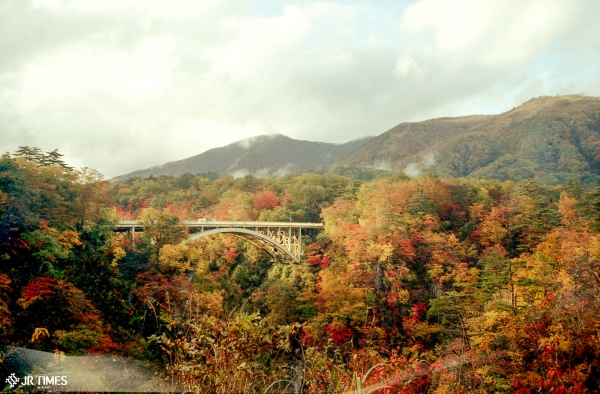Gorge-ous Naruko: A beginner's guide to Miyagi Prefecture's top autumn spot (Part 2)

Read the first part of my autumn adventure to Naruko Gorge here!
Autumn goodness
Naruko Gorge Viewpoint from the other point of view at Ofukazawa Bridge. (Image credit: JR Times / Sue Lynn)
In my previous article, I talked about how I got to Naruko Gorge, one of Tohoku’s top autumn foliage spots in Miyagi Prefecture. Upon arriving, I was welcomed by the crisp autumn air that one might only experience outside of city areas and the amazing autumn hues. What first caught my attention wasn’t the viewpoint’s rest house (鳴子峡レストハウス Naruko-kyō-resutohausu), but rather, the dozens of people with their cameras, tripods, and huge lenses huddling at the Ofukazawa Bridge (大深沢橋 Ōfukazawa-bashi).
View of the tunnel where the Riku-East Line trains would slowly creep out from. (Image credit: JR Times / Sue Lynn)
It turns out that these were avid trainspotters who were eagerly waiting for the Riku-East Line train to peek out through the tunnel that cuts through the valley of Naruko Gorge. This photo opportunity comes about 15 times a day when the train traverses between Naruko Onsen Station and Nakayamadaira-Onsen Station, and there’s even a schedule that’s put up around the area to let you know about this in advance.
Schedule of the Riku-East Line train (including the Resort Minori) passing through between Naruko-Onsen Station and Nakayamadaira-Onsen Station. (Image credit: Carissa Loh)
While I was lucky enough to catch the Resort Minori train heading towards Nakayamadaira-Onsen Station at around 11:28am, unfortunately I came with no proper photography gear to capture this great photo-op. Otherwise, it should look something like this:

Resort Minori standing out in the golden hues of autumn leaves. (Image credit: JR East)
The train is intentionally slowed down at such times, so get your cameras ready and snap as many photos as you'd like.
After the train had fully left our sight, I noticed that most of the trainspotters had quickly packed their gears and were headed for the rest house. To avoid joining another crowd, I made my way to a nearby observation deck called Naruko Gorge New Observation Deck (鳴子峡新展望台 Narukokyō-shintenbō-dai) at the other side of Ofukazawa Bridge.
(Image credit: JR Times / Sue Lynn)
The observation deck was quite literally gorged by the autumn trees of Naruko Gorge. A clear view of the Oya River (大谷川 Ōyagawa) that slithers through the rocky terrains of Naruko can be seen from the platform. I felt so close to nature that I didn’t want to leave. But the cold and wet weather persuaded me to head back to the rest house for warmth and food.
(Image credit: JR Times / Sue Lynn)
For lunch, I made my way back to the rest house to get my hands on local seasonal delicacies. Even from a distance, I could already spot a queue lined up for food right at the entrance of the rest house. While the shop sold a decent variety of light meals and snacks like tamakon (玉こん konjac ball) and agemanju (揚げまんじゅう fried manju), their bestseller was the kinokoshiru (きのこ汁 miso soup with mushrooms). It was easily one of the best soups I’ve ever had! There’s something especially comforting about a nice, warm bowl of kinoko shiru on a cold, wet day. Since it was lunchtime, the rest house’s indoor seating area was very packed so I chose a seat at the outdoor seating area instead and it was a dining experience with a gorgeous (pun-intended) view.
Initially, I had planned to visit one of the hot spring facilities nearby Nakayamadaira-Onsen Station or even the Kokeshi Museum before calling it a day. But since it was still raining, I decided to stick around at the rest house a little longer and browsed through the souvenir shop that was well-stocked with local produce, snacks, and even kokeshi dolls.

(Image credit: JR Times / Sue Lynn)
When the drizzling gradually became lighter, I ventured on to another trail near the viewpoint and rest house. Although the ground was wet due to the rain, the walking paths were wide enough and the steps weren’t steep. Once again, I was taken aback by nature’s beauty in all colours imaginable on the autumnal spectrum. I remember just stopping to admire every stream and every fallen momiji (紅葉 red leaves). I was, in short, shookt.
The many shades of autumn leaves in Naruko Gorge. (Image credit: JR Times / Sue Lynn)
The other side of Ofukazawa Bridge along Ofukazawa Promenade. (Image credit: JR Times / Sue Lynn)
The last place I checked out before making my move was (yet again) another walking route, called Ofukazawa Promenade (大深沢遊歩道 Ōfukazawa-yūhodō) and my only regret in this trip was not exploring this route sooner. The path here was a lot wider and quieter than the previous treks I took, and it featured a breathtaking view of another side of the Ofukazawa Bridge that’s not facing the rest house. Just 10 minutes into my stroll, it started to rain once again. Afraid of getting stranded and missing my bus back to the train station, I hurriedly made my way back to the bus stop. Ofukazawa Promenade has two entrances, and one of them is located near the Naruko Gorge New Observation Deck.
Resort Minori: The Autumn Joyful Train
In transit at Naruko-Onsen Station. (Image credit: JR Times / Sue Lynn)
I managed to take the bus back to Naruko Onsen Station where I waited for the 4pm Resort Minori Joyful Train. Just when I thought my autumn trip was over, the Resort Minori brought autumn back to me. Lacquered in deep red and black, the train’s exterior stands out regardless of the season and is reminiscent of the region’s autumnal colours.

(Image credit: JR East)
The word Minori (実り) actually means “harvest”, a term that is closely associated with autumn. So when locals say “実りある” (minori aru), it means that the harvest is bountiful, fulfilling, and fruitful. Similarly, the Resort Minori aims to bring you through a fulfilling visit through the region along the Riku-East Line, whether you are here to see the abundance of autumn trees or a fulfilling hot spring visit to recharge your body.
Wide windows allow passengers to enjoy the autumn sceneries of Miyagi Prefecture. (Image credit: JR Times / Sue Lynn)
Despite the long journey it was to get to and out of Naruko Gorge, I definitely felt recharged by just riding on the Resort Minori. As you can see in the photos above, the interior and seats exude warm hues of red and orange with motifs of momiji, making the feeling of autumn very present in the three-car train. My favourite part about the train was how spacious the legroom was, which could properly fit a medium-sized suitcase. I would also recommend getting window seats, as the wide windows provide excellent views of the scenery along the tracks.
Observation spaces can be found at the front and back of the Resort Minori. (Image credit: JR Times / Sue Lynn)
If the legroom isn’t enough and you wish to stretch your legs, you can even head over to the observation space or event venue. The observation spaces can be found at both the front and back of the Resort Minori, where passengers can get a full frontal (and back) view of the countryside.
(Image credit: JR Times / Sue Lynn)
The event venue in the middle car features a cute mini Resort Minori that doubles up as a sofa (for kids) as well as reading materials providing sightseeing information about the surrounding area. Depending on the time of your visit, you can also catch a variety of local programmes that highlights the beauty of the region along the Riku-East Line.
But of course if you prefer to just rest until you reach Sendai Station, the reclining seats and spacious legroom on the Resort Minori should just do the trick.
Did I regret not spending longer time at Naruko Gorge? Yes. But did I regret choosing it as my first ever autumn destination in Japan? Absolutely not. If I was given the chance, I would love to revisit and allocate time to do more sightseeing around this beautiful region. Even if you’ve visited Japan in autumn several times before, I highly reckon that Naruko Gorge would easily top your list of autumn destinations. Naruko Gorge isn’t the only autumn place to visit in Tohoku—here are more places that you can fit into your next autumn itinerary to Japan.
Header image credit: JR Times / Sue Lynn





